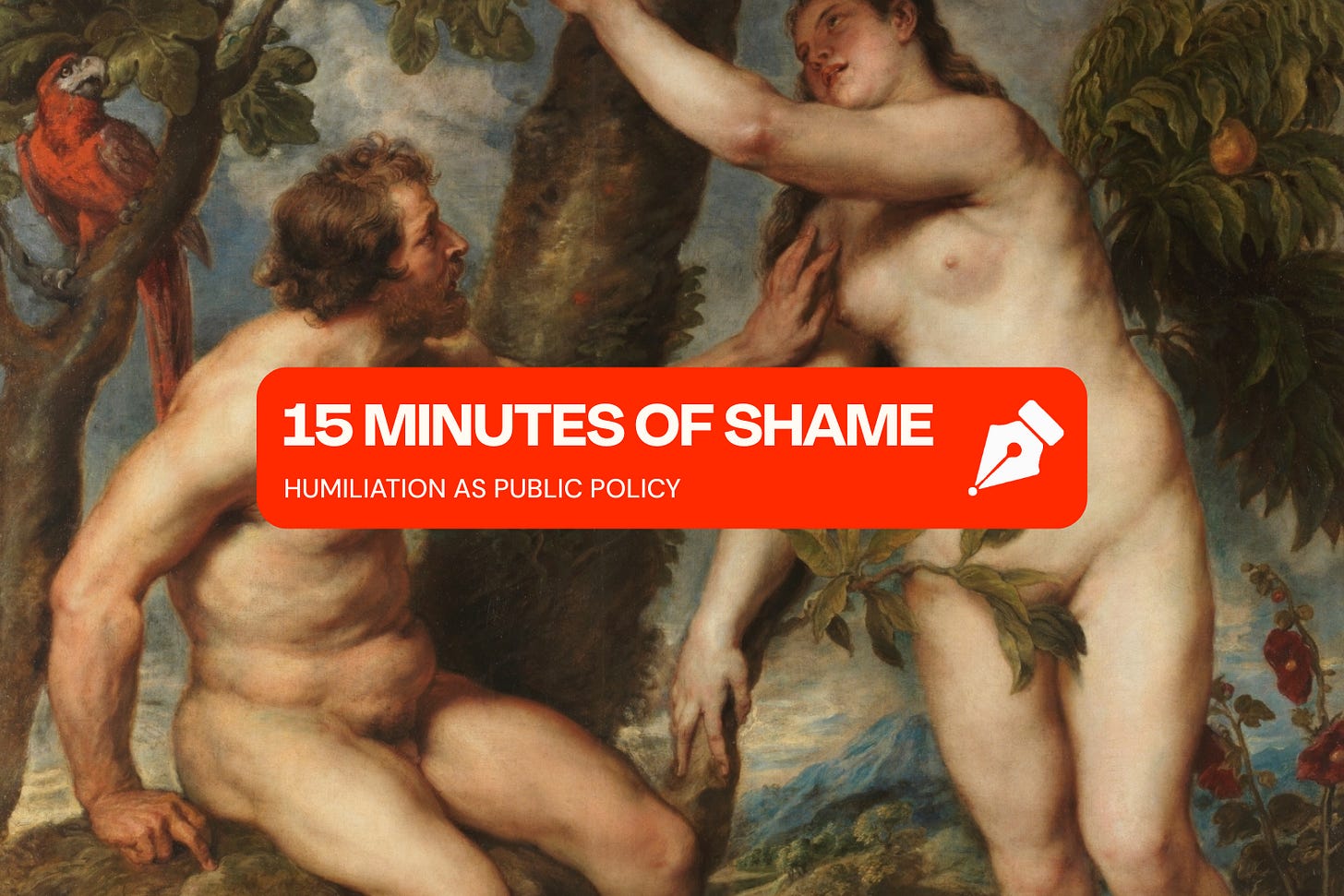15 Minutes of Shame
Humiliation as public policy
The first consequence for eating the forbidden fruit was shame. Before they are struck out of the Garden of the Eden, Adam and Eve realise for the first time that they are naked, and, out of shame, sew loincloths out of fig leaves. Humanity’s first couture garments, brought to you by shame.
If the bible isn’t your speed, we can look to medieval punishments like the stocks or pillories, where petty criminals were publicly restrained by their ankles or wrists and left in the town square for the populace to laugh and jeer at them. There is no overstating the pettiness of the crimes: individuals were put in the stocks for swearing and for public drunkenness. The defining logic behind punishments like these was the idea that the threat of being exposed to your community would keep people in line. We know that stocks and pillories have been around since Ancient Greece, and the instinct behind them didn't change. Shame works because it turns private failings into public spectacle: the sinner stands still while everyone else looks, laughs, and judges.
This is the heart of shame: it is an emotion that requires at the very least an imagined other. It is not the nakedness itself that brings shame to Adam and Eve, but the idea that they are both naked and perceived. The stocks functioned as effective punishment because they leveraged the notion that on some level a village would be happy to participate in the humiliation of someone who “deserved” it.
Today our town square is the endless scroll. The internet’s shame machine takes advantage of our ancient embarrassment, keeping itself running through the endless power source of human humiliation. Click bait headlines, screenshots of regrettable behaviour, addictively abject content being pushed via recommender systems. These all trade on the same base instinct: we are terrified of being caught out in front of others, and unable to resist the urge of joining in when someone else has been caught.
Earlier this month, the CEO of the data analytics outfit Astronomer and the company’s chief people officer were seen canoodling during a Coldplay concert. Their panicked response to seeing themselves broadcast to the entire venue swiftly went viral, and the two people in it were identified almost immediately. Stocks and pillory. Just a few days later Astronomer announced a new, interim CEO, whilst the image of the two of them was parodied and lampooned by everyone from sports team mascots to the official IKEA Instagram account. The company itself joined in the fun, publishing a tongue in cheek reaction featuring Gwyneth Paltrow.
This same dynamic is what makes image-based abuse so powerful. The typical lifespan of a non-consensually shared image is as follows: a photo or video is first shared with an intimate partner, and then its initial recipient passes it on — sending it to a group of friends or uploading it to a social media platform. The purpose is to activate the shame machine: exposing the sender in a vulnerable moment to prying eyes they never consented to. The abuser has successfully trapped their victim in the stocks. The rest is up to the viewing public, who are all too willing to step up to their role. Although the reaction varies from case to case, these images are often shared further. If the survivor is a person with a public profile, they might even make it into tabloid newspapers.
Perhaps unknowingly, the perpetrator is also taking advantage of the fact that their victim is likely to experience a secondary source of shame: having taken the photo in the first place. Half of all survivors of image-based abuse choose not to report their experience through official channels. When speaking about what happened to them, one sentiment appears with alarming frequency: “It was my own fault.” In discussions of how to dismantle cultures of victim-blaming, we sometimes see the notion that the ‘burden of shame’ is placed on the wrong person. The person being lampooned should never be the victim, but the perpetrator. In doing so though, we are simply turning the mob from one direction to the other. The solution cannot be to find the ‘right’ target for our collective rage. We have to refuse to participate in the spectacle at all.
We did away with stocks and pillories in the 19th century. By 1837, the pillory was formally abolished via a parliamentary act, and while stocks were never ‘officially’ discontinued, their use fell out of fashion and the medieval statute that had once demanded every town in England have one was repealed in 1863. Speeches proposing their abolition emphasised how public punishment bred cruelty, and argued for a justice system that corrected, rather than entertained.
Yet we have rebuilt the pillory in lines of code. If wooden frames once held ankles and wrists, today our screens freeze human behaviour in place while the crowd gathers. Minimising shame as public policy does not mean excusing harm. If the long history of shame tells us one thing, it’s that we will never be able to legislate it out of human nature. Adam and Eve ate the fruit long ago, and I don’t see us getting back into the Garden of Eden. But in the same way that Victorian MPs saw how the stocks leveraged our worst instincts, we can engineer systems that refuse to feed off them. Public policy should be designed not to exploit our most ancient vulnerabilities, but to protect against them. The measure of good governance should not be ‘how effectively can we shame the wayward’, but whether we've sufficiently ensured that shame cannot be industrialised, commodified, or weaponised.



